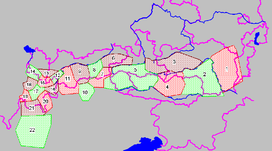Central Eastern Alps
| Central Eastern Alps | |
|---|---|
 | |
| Highest point | |
| Peak | Piz Bernina |
| Elevation | 4,049 m (13,284 ft) |
| Coordinates | 46°22′57″N9°54′29″E/ 46.38250°N 9.90806°E |
| Geography | |
 Central Eastern Alps ranges (purple lines showing international borders and borders ofAustrian states):
| |
| Countries | Austria,Switzerland,Liechtenstein,Italy andSlovenia |
| States | Vorarlberg,Tyrol,Salzburg,Carinthia,Styria,Graubünden,South TyrolandLombardy |
| Parent range | Eastern Alps |
| Geology | |
| Orogeny | Alpine |
| Age of rock | Mesozoic and Tertiary |
| Type of rock | GneissandSlate |
TheCentral Eastern Alps(German:Zentralalpen or Zentrale Ostalpen), also referred to asAustrian Central Alps(German:Österreichische Zentralalpen) or justCentral Alps,[1]comprise themain chainof theEastern Alpsin Austria and the adjacent regions ofSwitzerland,Liechtenstein,Italy andSlovenia.South them is theSouthern Limestone Alps.
The term "Central Alps" is very common in theGeography of Austriaas one of the seven major landscape regions of the country. "Central Eastern Alps" is usually used in connection with theAlpine Club classification of the Eastern Alps(Alpenvereinseinteilung,AVE). The Central Alps form the eastern part of theAlpine divide,its central chain of mountains, as well as those ranges that extend or accompany it to the north and south.
The highest mountain in the Austrian Central Alps isGrossglocknerat 3,798 metres (12,461 ft).
Location
[edit]The Central Alps have the highest peaks of the Eastern Alps, and are located between theNorthern Limestone Alpsand theSouthern Limestone Alps,from which they differ in geological composition.
The term "Central Eastern Alps" may also be used more broadly to refer to a larger area of theEastern Alps,mainly located inAustria,extending from the foot of theBergamasque AlpsatLake Comoand theBernina Rangein theGraubündencanton of easternSwitzerlandalong theLiechtensteinshore of theRhinein the west as far as to the lowerpromontorieseast of the riverMurincluding theHochwechselin AustrianStyria.The valleys of the riversInn,SalzachandEnnsmark their northern boundary, theDrauriver (roughly corresponding to thePeriadriatic Seam) their southern border. In the proposedSOIUSAsystem, the "Central-eastern Alps" include theRhaetian Alps,of which theBernina Rangeincludes the 4,049-meterPiz Berninain Switzerland, the easternmost 4,000-meter peak of the Alps. In the AVE system, however, the fulllist of mountain groups in the Alpine Club classification of the Eastern Alpsincludes the Bernina and neighboring ranges within the Western Limestone Alps, not the Central Eastern Alps as the Alpine Club defines them.
Central Alps as a major landscape region in Austria
[edit]In Austria, the Eastern Alps are divided into theNorthern Alps,theGreywacke zone,the Central Alps and theSouthern Alps.The latter lie partly in SouthCarinthia,but mainly inNortheast Italy.
The Central and Northern Alps are separated by the Northern Longitudinal Trough (nördliche Längstalfurche), the lineKlostertal–Arlberg–InnValley–SalzachValley as far asLake Zell–WagrainHeights–UpperEnnsValley–Schober Pass–MürzValley Alps–Semmering–southernVienna Basin.[2]The Central Alps and Southern Alps are separated from one another by the Southern Longitudinal Valley (südlichen Längstalzug)Puster Valley(RienzValle–ToblachField–upperDrava(Drau) Valley)–Drava Valley–KlagenfurtBasin–Meža(Mieß), or the Periadriatic Seam, which is not entirely identical with the Southern Longitudinal Trough.
Geomorphology
[edit]The range has the highest summits in the Eastern Alps and is the mostglaciated.In the transition zone between the East and West Alps, its peaks clearly dominate the region to the west (Piz d'Err,Piz Roseg). On the perimeter, however, there are also less high, often less rugged mountain chains, like theGurktal Alpsand the eastern foothills.
The Eastern Alps is separated from theWestern Alpsby a line fromLake ConstancetoLake Comoalong theAlpine Rhinevalley and via theSplügen Pass.
Geology
[edit]
and several windows, regional nappes and islands
The Central Alps consist mainly of thegneissandslaterocks of the variousAustroalpine nappes(Lower and Upper Austroalpine), with the exception of theHohe TauernandEngadine windows,where they are composed mostly ofJurassicrock andlimestonesand, locally, (BergellandRieserferner) also ofgranite.The Austroalpine nappes arethrustedover thePenninicnappe stack.Massifs ofautochthonous,crystalline rock,which hardly moved at all duringAlpine folding,do not occur in the Central Alps – unlike the case in the Western Alps. The aforementioned granite intruded near thefracture zoneof thePeriadriatic Seam.TheWestern Alpsdo not have this division into theNorthern Limestone Alps,Central Alps andSouthern Limestone Alps.
The Austroalpine submerges itself at the eastern edge of the Alps under theTertiarysediments of the Alpine Foreland in the east and thePannonian Basin.This fracture zone exhibits activevolcanism(e.g. in theStyrianthermal region).
Alpine Club classification
[edit]The Central Eastern Alps also comprise the following ranges of the West Eastern Alps according to AVE classification, which geologically belong to theSouthern Alpsand are also subsumed under the Western Limestone Alps division.:
- ^The Kitzbühel Alps and the adjacentSalzburg Slate Alpsas part of the Greywacke zone are either counted as part of the Northern Limestone Alps or the Central Alps – geologically they form the bedrock of theLimestone Alps,and the slip zone, on which the latter were thrust northwards
| AVE- No. |
Name | Map | Country | Highest mountain | Height (m) | Image |
|---|---|---|---|---|---|---|
| 63 | Plessur Alps | Aroser Rothorn | 2,980 | 
| ||
| 64 | Oberhalbstein Alps | Piz Platta | 3,392 | 
| ||
| 65 | Albula Alps | Piz Kesch | 3,418 | 
| ||
| 66 | Bernina Group | Piz Bernina | 4,049 | 
| ||
| 67 | Livigno Alps | Cima de’ Piazzi | 3,439 | 
| ||
| 68 | Bergamasque Alps[a] | Pizzo di Coca | 3,052 | 
|
- ^TheBergamasque Alpsare – geologically and petrologically – part of the Southern Limestone Alps, and thus the Southern Alps
TheOrtler Alpsas well as theSobretta-Gavia Groupare also sometimes classified with the Central Alps, because they lie north of the geological fault of the Periadriatic Seam; in a general regional geographic sense, however, they are seen as part of theSouthern Limestone Alps,because they are found south of the longitudinal troughVeltlin(Adda)–Vintschgau(Etsch).[3]Also in terms of rock, theOrtlermain crest is part of the Southern Limestone Alps.
See also
[edit]References
[edit]- ^Not to be confused with the other meaning of Central Alps i.e. theSwiss Alps.
- ^AlpsinAustria-Forum(in German)(at AEIOU)
- ^Peter Holl:Alpenvereinsführer Ortleralpen
External links
[edit]![]() Media related toCentral Eastern Alpsat Wikimedia Commons
Media related toCentral Eastern Alpsat Wikimedia Commons



























